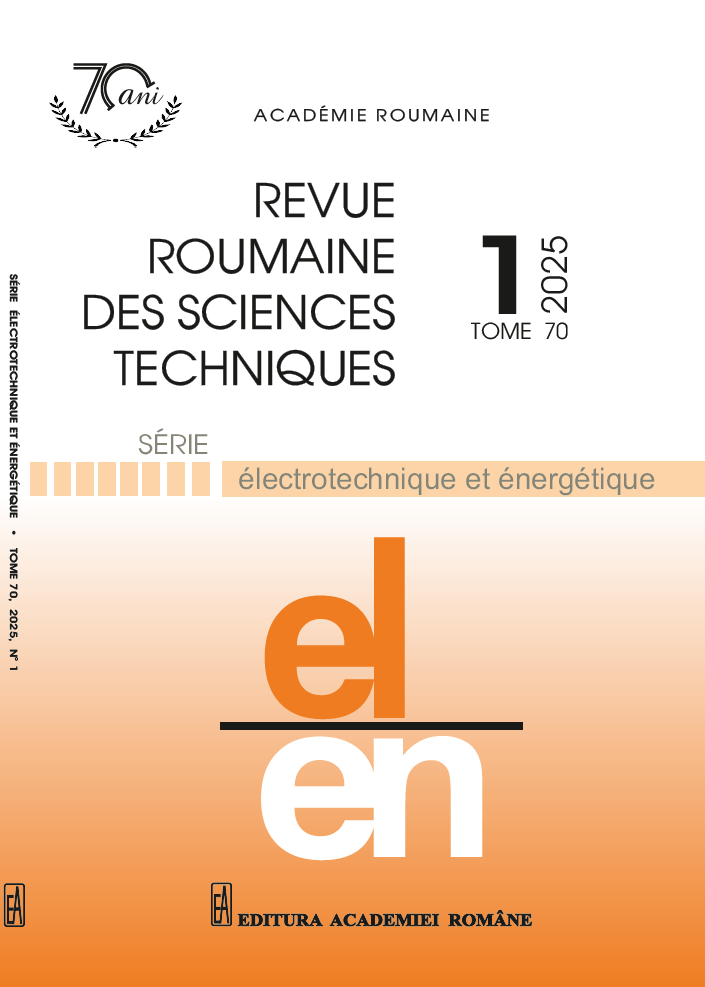CIRCULARLY POLARIZED PERIODIC LEAKY-WAVE ANTENNA BASED ON A COAXIAL LINE WITH HELICAL SLOT
DOI:
https://doi.org/10.59277/RRST-EE.2025.1.15Keywords:
Leaky-wave antennas, Circular polarization, Frequency-scanned, Helical slot, Periodic leaky-wave antenna (LWA), Satellite communicationsAbstract
A novel coaxial-line-based helical leaky-wave antenna (LWA) with circular polarization (CP) is presented in this work. The CP is achieved thanks to a helical-shaped slot edged on the outer conductor of the coaxial line that allows for controlled radiation when the fundamental TEM mode of the coaxial line is fed. Thus, a periodic-like LWA is formed with frequency-scanning of a conical beam and suppressed open stopband achieved thanks to the continuous radiation along the helical slot. This way, the radiation efficiency can be kept high in a wide scanning range. A prototype has been designed and manufactured for validation with beam scanning from -90° to 12° in the 8-16 GHz frequency range. The efficiency is above 75 % in almost all this frequency band with a simulated axial ratio below 3 dB, showing proper CP performance.
References
(1) D.R. Corrêa, A. Silva de Morais, F.L. Tofoli, Non-isolated quadratic SEPIC converter without electrolytic capacitors for LED driver applications, 15th Brazilian Power Electronics and 5th IEEE Southern Power Electronics Conference, pp. 1–7 (2019).
(2) Y. Wang, J.M. Alonso, X. Ruan, A review of LED drivers and related technologies, IEEE Trans. Ind. Electron., 64, 7, pp. 5754–5765 (2017).
(3) C.C. Raicu, G.C. Seritan, B. Enache, 48 V network adoption for automotive lighting systems, Rev. Roum. Sci. Techn. – Électrotechn. et Énerg., 66, 4, pp. 231–236 (2021).
(4) G. Vacheva, N. Hinov, B. Gilev, Computer investigation of SEPIC DC-DC converter for LED lighting applications, Second Balkan Junior Conference on Lighting, pp. 1–4 (2019).
(5) J. Singh, P. Mahajan, R. Garg, Design & implementation of solar fed intensity-controlled streetlight, 2nd IEEE International Conference on Power Electronics, Intelligent Control, and Energy Systems, pp. 671–676 (2018).
(6) S. Ahmad, N.M.L. Tan, M.Z. Baharuddin, G. Buticchi, A high-performance isolated SEPIC converter for non-electrolytic LED lighting, in IEEE Access, 9, pp. 149894–149905 (2021).
(7) V. Naithani, A.N. Tiwari, S. Dobhal, Simulation of SEPIC converter fed LED’s, International Journal of Engineering Science and Technology, 4, 3, pp. 1015–1020 (2012).
(8) S. Singh, B. Singh, Single-phase SEPIC based PFC converter for PMBLDC motor drive in air-conditioning system, Asian Power Electronics Journal, 4, 1, pp. 16–21 (2010).
(9) D.S.L. Simonetti, J. Sebastian, J. Uceda, The discontinuous conduction mode SEPIC and CUK power factor pre-regulators: analysis and design, in IEEE Trans. on Industrial Electronics, 44, 5, pp. 630–637 (1997).
(10) A. Sureshkumar, R. Gunabalan, Design and implementation of single switch control DC-DC converter with wide input variation in automotive LED lighting, Int. Trans. Elect. Energy Syst., 31, 4 (2021).
(11) M. Dalla Vecchia, G. Van den Broeck, S. Ravyts, J. Tant, J. Driesen, A family of DC–DC converters with high step-down voltage capability based on the valley-fill switched capacitor principle, in IEEE Transactions on Industrial Electronics, 68, 7, pp. 5810–5820 (2021).
(12) S. Hariprasath, R. Balamurugan, A valley-fill SEPIC-derived power factor correction topology for LED lighting applications using one cycle control technique, International Conference on Computer Communication and Informatics, IEEE (2013).
(13) H. Ma, C. Zheng, W. Yu, J.-S. Lai, Bridgeless electrolytic capacitor-less valley fill AC/DC converter for twin-bus type LED lighting applications, 1st International Future Energy Electronics Conference, pp. 304–310 (2013).
(14) D. Dah, C. Lu, Analysis of an AC-DC valley-fill power factor corrector, ECTI Transactions on Electrical Eng., Electronics, and Communications, 5, 2 (2007).
(15) N. Molavi, H. Farzanehfard, Load-independent hybrid resonant converter for automotive LED driver applications, in IEEE Trans. on Power Electronics, 377, pp. 8199–8206 (2022).
(16) Z. Zhang, J. Lin, Y. Zhou, X. Ren, Analysis and decoupling design of a 30 MHz resonant SEPIC converter, in IEEE Transactions on Power Electronics, 31, 6, pp. 4536–4548 (2016).
(17) A. Alexandru, N.V.Petrescu, I.V. Grecu, J.L.G. Tomero, Analysis and design of line-source slotted-coaxial feeders for conical reflectors antennas, International Conference on Communications (COMM) (2018).
(18) A. Alexandru, M.P. Garcia, I.V. Grecu, J. Luis, G. Tornero, Analysis and design of line-source slotted-coaxial feeders for conical reflectors antennas, International Conference on Communications (COMM) (2022).
Downloads
Published
Issue
Section
License
Copyright (c) 2025 REVUE ROUMAINE DES SCIENCES TECHNIQUES — SÉRIE ÉLECTROTECHNIQUE ET ÉNERGÉTIQUE

This work is licensed under a Creative Commons Attribution-NonCommercial-NoDerivatives 4.0 International License.


